Imagine walking through Norway’s magical forests, surrounded by fresh air and the sound of pine trees. This is where the stunning Norwegian Forest Cat was born. These cats have won the hearts of many, thanks to their beautiful looks and strong spirit. Their history is tied to Norway’s beautiful landscapes and the Viking legacy.
Table of Contents
The Viking Legacy and Historical Origins
The Norwegian Forest Cat, also known as the Skogkatt, has a rich history. It’s deeply connected to Norse mythology and Viking culture. These cats are believed to come from cats brought by Viking explorers or Crusaders to the Norwegian forests.
Over centuries, they adapted and evolved to thrive in the harsh climate.
Norse Mythology Connection
In Norse folklore, the Norwegian Forest Cat was linked to the goddess Freyja. She was known for love, beauty, and warfare. Freyja was often shown with two large cats pulling her chariot.
This symbolizes the cat’s strength and protective nature.
Viking Ship Companions
Cats were valued by Vikings for controlling rodents on their voyages and in settlements. Archaeological evidence shows Norwegian Forest Cats were common on Viking ships. Their sturdy build and thick coats were perfect for the harsh sea environment.
Evolution in Scandinavia
Over time, Norwegian Forest Cats adapted to Scandinavia’s rugged landscape. They developed a double-layered coat and powerful, agile bodies. These traits helped them survive cold winters and dense forests.
| Statistic | Value |
|---|---|
| Norwegian Forest Cats are the primary breed associated with Vikings | True |
| Cat remains have been found at various Norse archaeological sites | True |
| The goddess Freyja was often depicted with two large cats in Norse mythology | True |
| Norwegian Forest Cats were known for their robust build, thick double coat, and tufted ears | True |
| The Vikings potentially spread cats throughout Europe as they traveled and traded | True |
The Norwegian Forest Cat’s long history shows the Vikings’ deep respect for these cats. It highlights the rich cultural heritage of the Vikings and their reverence for these majestic felines.
Physical Characteristics of the Norwegian Forest Cat
The Norwegian Forest Cat is a big, strong breed. They have a semi-long coat in many colors and patterns. Their sturdy build, triangular head, and large almond-shaped eyes are striking. Their thick, water-resistant coat helps them stay warm in cold climates.
These cats grow slowly, reaching full size in up to five years. Males weigh 12 to 16 pounds, while females are slightly smaller, weighing 9 to 12 pounds. They come in various colors like black, blue, and red, with patterns such as solid and tabby.
| Physical Trait | Characteristic |
|---|---|
| Size | Large, muscular build |
| Head Shape | Triangular |
| Eye Shape | Large, almond-shaped |
| Ear Tufts | Prominent, tufted |
| Coat Length | Semi-long, double-layered |
| Coat Colors | Variety of colors and patterns, excluding chocolate, lilac, or Siamese markings |
| Maturation Time | Up to 5 years to reach full adult size |
| Weight Range | Males: 12-16 lbs, Females: 9-12 lbs |
The Norwegian Forest Cat stands out with their large size, strong build, and semi-longhaired coat. These cats are well-suited to the harsh Scandinavian climate. Their physical traits show their adaptation to cold weather.
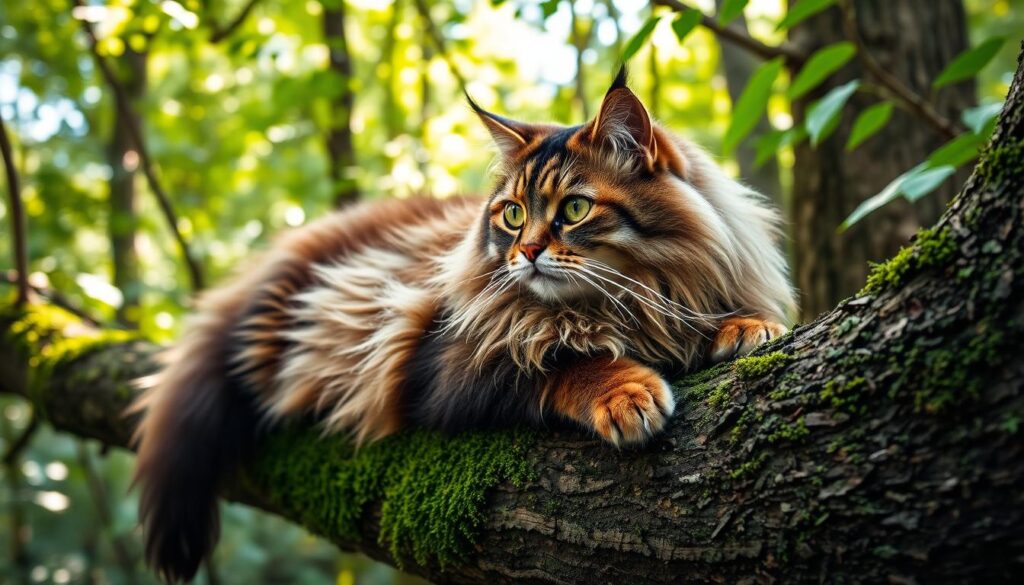
The Natural Adaptation to Cold Climates
Norwegian Forest Cats are known for their amazing ability to handle Scandinavian winters. Their double-layered coat is crucial for surviving the cold. The soft undercoat keeps them warm, and the top coat keeps them dry.
Double-Layered Coat Features
As winter comes, these cats grow a thick ruff around their neck and chest. This extra layer protects them from cold winds and wet snow. Their ears and toes are also covered, like natural “earmuffs” and “boots.”
Winter Adaptations
- Insulating undercoat for warmth
- Water-repellent topcoat for weather protection
- Neck ruff and tufted ears and toes for added shielding
Seasonal Changes
In warmer months, their coat gets shorter but stays water-resistant. This helps them stay cool in the summer without losing their winter toughness.
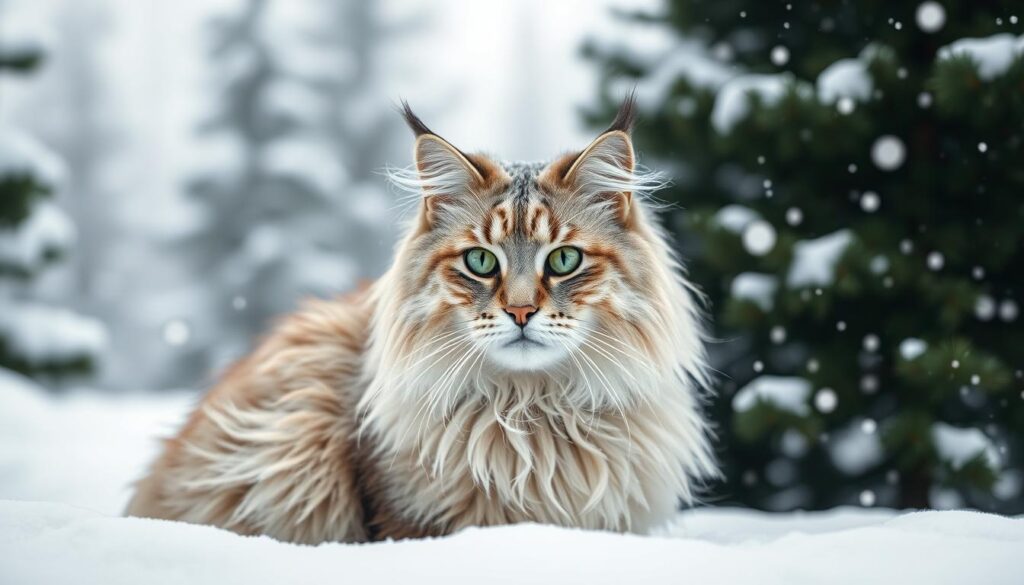
The Norwegian Forest Cat’s ability to survive harsh winters shows their strength and resilience. They are among the most sturdy and resilient natural cat breeds worldwide.
Climbing Abilities and Forest Skills
Looking for a cat that’s agile and versatile? The Norwegian Forest Cat, or “Wegie,” is perfect. They’re known for their climbing skills, thanks to their forest-dwelling past.
Wedgies have strong, thick claws that help them climb trees and other vertical surfaces. They can even go down headfirst with ease. Their muscular build and balanced body make them agile and strong, great for hunting and exploring.
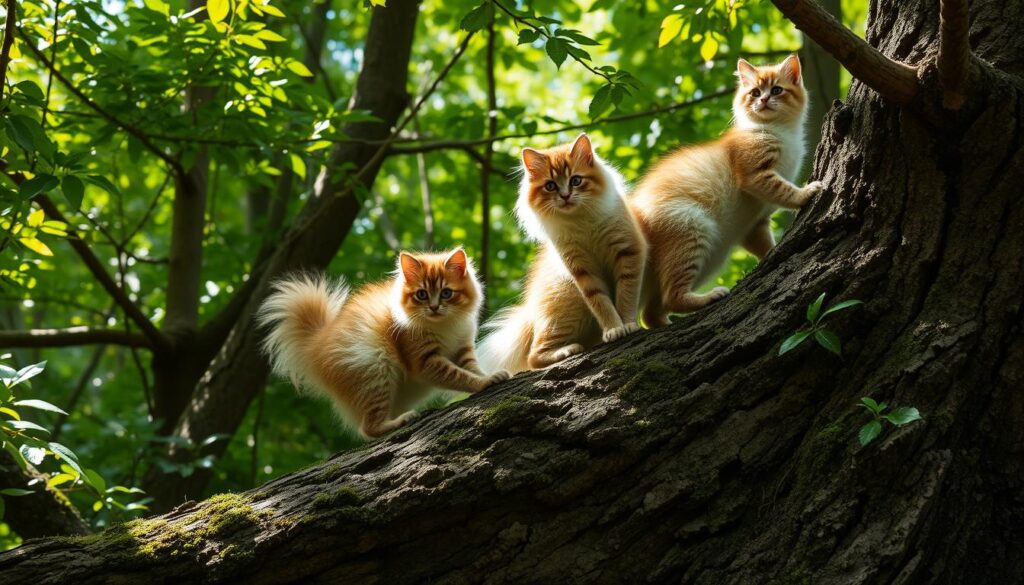
While many cats like to climb, Wegies take it to a new level. They’re at home in the forest, using their climbing to move through the terrain confidently. Their water-resistant double coat also helps them thrive in Scandinavian landscapes.
Wedgies are perfect for families who want a playful indoor cat or a companion for outdoor adventures. Their climbing skills and forest abilities make them a unique and captivating addition to any home.
From Near Extinction to National Treasure
The Norwegian Forest Cat, a majestic feline with a rich history, faced a perilous predicament in the mid-20th century. The breed was on the brink of extinction due to indiscriminate crossbreeding. However, a dedicated effort by Norwegian breeders and enthusiasts saved the Norwegian Forest Cat from this dire fate.
Conservation Efforts
In the 1970s, a preservation program was established to safeguard the unique Norwegian Forest Cat breed. Through selective breeding and a concerted focus on maintaining the breed’s distinct characteristics, these conservation efforts helped the Norwegian Forest Cat regain its foothold and ensure its continued existence.
Recognition as Norway’s National Cat
The Norwegian Forest Cat’s cultural significance in its homeland was further cemented when the late King Olaf designated it as Norway’s national cat. This official recognition solidified the breed’s status as a cherished symbol of Norwegian heritage and pride.
Modern Popularity
The Norwegian Forest Cat’s journey from near extinction to national treasure has been remarkable. In 1979, the breed was introduced to the United States, and it quickly gained popularity among cat enthusiasts. By 1993, the Norwegian Forest Cat achieved full championship status from the Cat Fancier’s Association, cementing its place as one of the most beloved cat breeds in the country.
Today, the Norwegian Forest Cat continues to captivate hearts and minds, both in its native Norway and across the world. Its resilience, regal appearance, and charming personality have made it a true feline icon, a living testament to the enduring spirit of this remarkable cat breed.
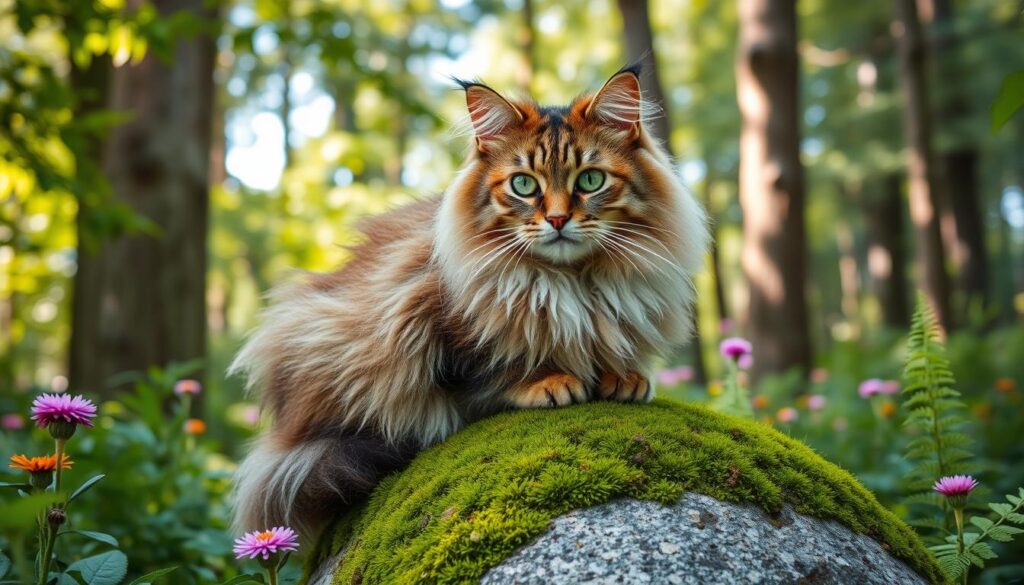
Temperament and Personality Traits
Thinking about getting a cat? The Norwegian Forest Cat, or Wegie, is a great choice. They are known for being gentle and friendly. This makes them perfect for families and homes with kids.
Wegies are smart and love to be around people. They fit well in different homes and enjoy playing. But, they can get too hot to sit on laps. They need daily play and activities to keep them happy.
Wedgies love their people but might not get along with small pets. It’s important to socialize and train them well. This helps everyone in the house get along.
| Trait | Description |
|---|---|
| Temperament | Gentle, mild-mannered, and adaptable |
| Intelligence | Moderate to high energy, loves climbing and exploring |
| Activity Level | Moderate to high energy, love climbing and exploring |
| Sociability | Enjoy being part of the family, but may not be lap cats |
| Hunting Drive | Strong hunting instincts, may not be suitable for homes with small pets |
The Norwegian Forest Cat is a loving and lively pet. They bring joy and excitement to your home.
Grooming and Maintenance Requirements
Owning a semi-longhaired cat like the Norwegian Forest cat breed means you need to groom them. They are easier to care for than some long-haired cats. But, regular grooming is key to keeping their coats healthy and preventing mats.
Seasonal Shedding Care
Norwegian Forest cats shed a lot in spring and fall. You’ll need to brush them more often during these times. Brushing several times a week helps remove loose hair and prevents hairballs.
Using a deep-tined comb or one with rotating tines is best. It helps get rid of the undercoat and spreads natural oils.
Basic Grooming Routine
- Brush your cat at least once a week with a high-quality comb or brush to remove dead and loose hair.
- Trim your cat’s nails every 10-14 days to prevent overgrowth.
- Clean your cat’s ears gently with a damp cloth or cotton ball to remove any dirt or debris.
- Brush your cat’s teeth 2-3 times per week to maintain dental health.
- Bathe your cat only when necessary, using a mild shampoo designed for cats.
Norwegian Forest cats rarely need baths because their coat is water-resistant. Their coat also repels dirt and mats less often. Regular grooming keeps your semi-longhaired cat looking and feeling great.
“Norwegian Forest Cats have an average lifespan of 14 to 16 years, with some individuals living beyond this range based on genetics, health conditions, diet, and care.”
Health Considerations and Lifespan
Norwegian Forest Cats are known for being sturdy and healthy. They can live from 12 to 16 years. But, like all breeds, they might face some health problems.
One big worry is hypertrophic cardiomyopathy (HCM), a heart issue. It’s important to get regular heart checks. They might also get glycogen storage disease type IV (GSD-IV) and pyruvate kinase deficiency (PK deficiency). These can be found with genetic tests.
To keep your Norwegian Forest Cat healthy, make sure they get all their shots and parasite treatments. Feed them well and give them lots of playtime. With the right care, they can live long, happy lives.
| Health Parameter | Statistic |
|---|---|
| Lifespan | 12-16 years |
| Weight Range | 12-16 pounds |
| Height Range | 9-12 inches |
| Common Health Concerns | Hypertrophic Cardiomyopathy, Glycogen Storage Disease Type IV, Pyruvate Kinase Deficiency |
Norwegian Forest Cats are great for many homes. They fit well with families, seniors, and other pets. By taking good care of them, you can make sure they live a long, happy life.
Diet and Nutrition Needs
Norwegian Forest Cats need a balanced diet to stay healthy and active. They do well with a mix of high-quality dry and wet food. Some cats also enjoy dehydrated raw options.
It’s key to choose protein-rich foods and avoid fillers or by-products. These can harm their health.
Feeding your cat the right amount is important. They can easily get too fat if they eat too much. Feed them twice a day and make sure they always have fresh water. Treats should not make up more than 10% of their daily food.
By giving your cat a nutritious diet, you help them stay healthy and full of energy. Remember, a balanced diet keeps them happy and at a good weight.

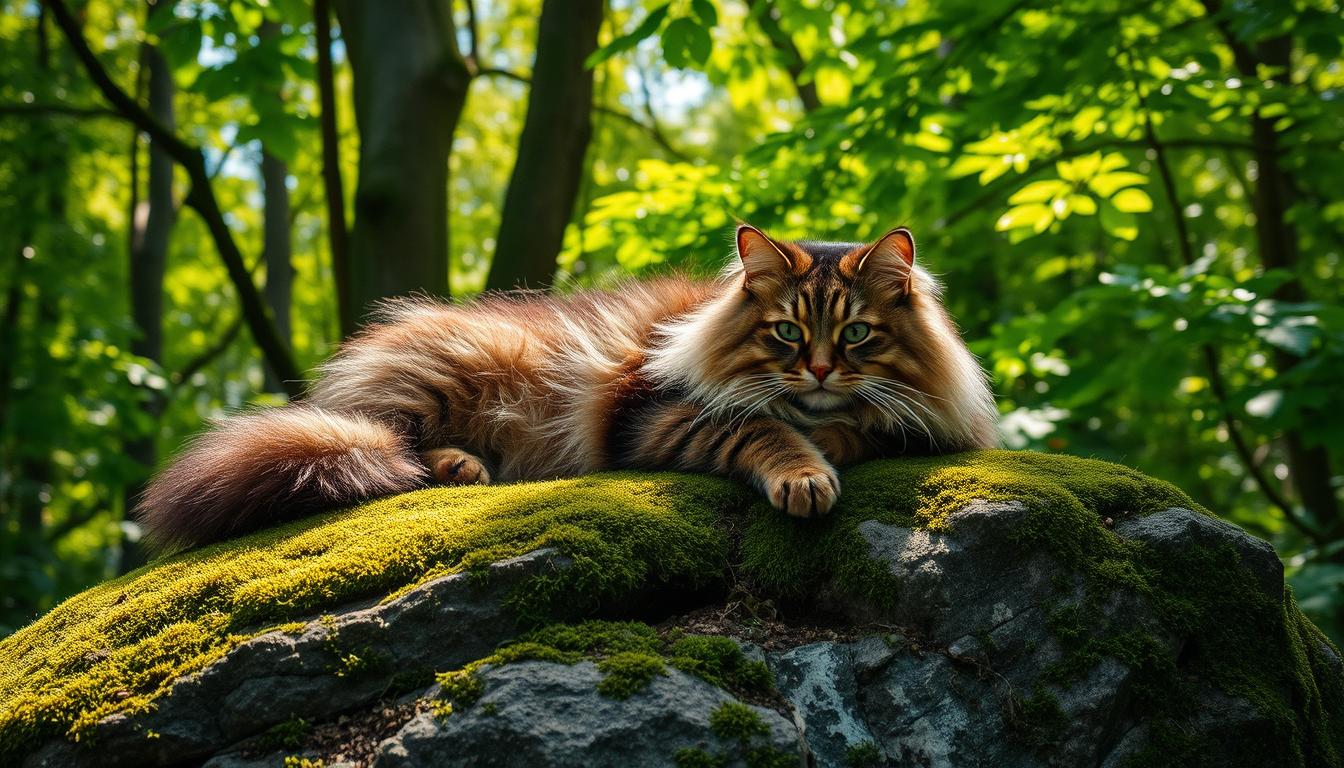
1 thought on “Norwegian Forest Cat”
Comments are closed.